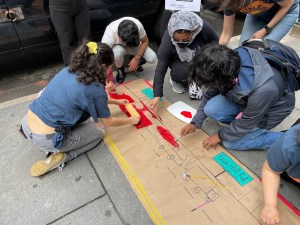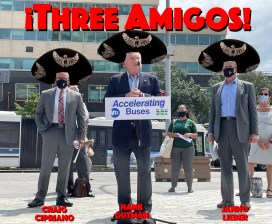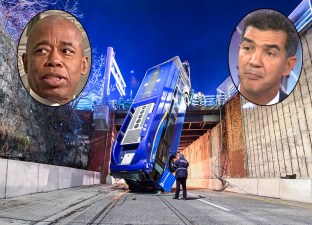MTA Boss: City Must Meet Its ‘Commitment’ to Bus Lanes This Year

A promise made has to be a promise kept.
MTA CEO and Chairman Janno Lieber said on Monday that the Adams administration must start hitting its legally mandated bus lane mileage benchmarks as laid out in the Streets Plan and as agreed to during a much-hyped 2022 transit summit between the Department of Transportation and regional transit authority.
“We have to start hitting numbers,” Lieber said about the Streets Plan requirement that the city build at least 30 miles of dedicated or “enhanced” bus lanes — a promise DOT has already told City Hall it is unlikely to meet. “The mayor and the MTA management made a commitment together after a meeting that was billed as a summit on bus service, so now we and the DOT have to do everything possible to make good on that commitment.”
Lieber’s comments came in the context of a discussion about congestion pricing, which has not earned widespread support in many neighborhoods where cars are popular, but perhaps wouldn’t be if residents and lawmakers in those areas supported the better transit that could make car ownership less popular.
To build dedicated bus lanes, Leiber said Adams will “need a little bit more cooperation in some cases from some neighborhoods [where] sometimes folks resist having bus lanes.
“The evidence is clear that bus lanes will allow us to run much faster buses, and there are many more people who depend on buses, especially in low-income neighborhoods, than own and move around in private automobiles,” he added.
The comments came after a year when the DOT was only able to install about 11.9 miles of bus lanes across the city despite a requirements to install 20 miles. Last June, after the MTA and DOT broke bread, Mayor Adams promised eight bus priority projects in 2022:
- Fordham Road and 207th Street, between 10th Avenue in Manhattan and White Plains Road in the Bronx
- Gun Hill Road, between Bainbridge and Bartow avenues in the Bronx
- University Avenue, between Kingsbridge Road and Washington Bridge in the Bronx
- Westchester Avenue at Pelham Bay Park Station in the Bronx
- First Avenue between 61st and 79th streets in Manhattan
- Avenues A and D, various segments in Manhattan
- 21st Street, between the RFK Bridge and the Queensboro Bridge in Queens
- Northern Boulevard, between Broadway and 114th Street in Queens
The administration finished five of the projects last year, but it wasn’t able to deliver on three big mileage proposals: Fordham Road, University Avenue and Northern Boulevard. Streetsblog’s report near the end of 2022 revealed that the DOT does not think it can hit the required 30 miles of bus lanes next year because of a shortage of both planning staff and construction crews. Bus and bike lane projects were also reportedly sacrificed for political convenience in 2022, though the city did at least begin work on the Northern Boulevard bus lane that Council Member Francisco Moya allegedly lobbied to stop.
City Hall all but confirmed those stories in the preliminary Mayor’s Management Report for Fiscal Year 2023, writing (on page 282), “Bus lane miles installed decreased 47 percent … compared to last year, mainly due to political opposition, the lack of staffing available as well as the availability of markings contractors, operating space constraints, and a delay in the delivery of in-house markings machinery required to complete scheduled projects.”
The DOT emphasized the positive that came out of last year, and said it has a productive relationship with the MTA.
“DOT improved the lives of 400,000 daily bus riders last year with projects that have made their service faster and more reliable,” said agency spokesman Vin Barone. “We’re working creatively, and in close partnership with the MTA, to deliver high-quality, high-impact projects to support bus service where New Yorkers depend on it the most.”
Advocates hailed Leiber for putting the mayor on notice.
“The chair is absolutely right,” said Riders Alliance Policy and Communications Director Danny Pearlstein. “Mayor Adams must keep his word to millions of bus riders and speed up the slowest buses in the nation.”



